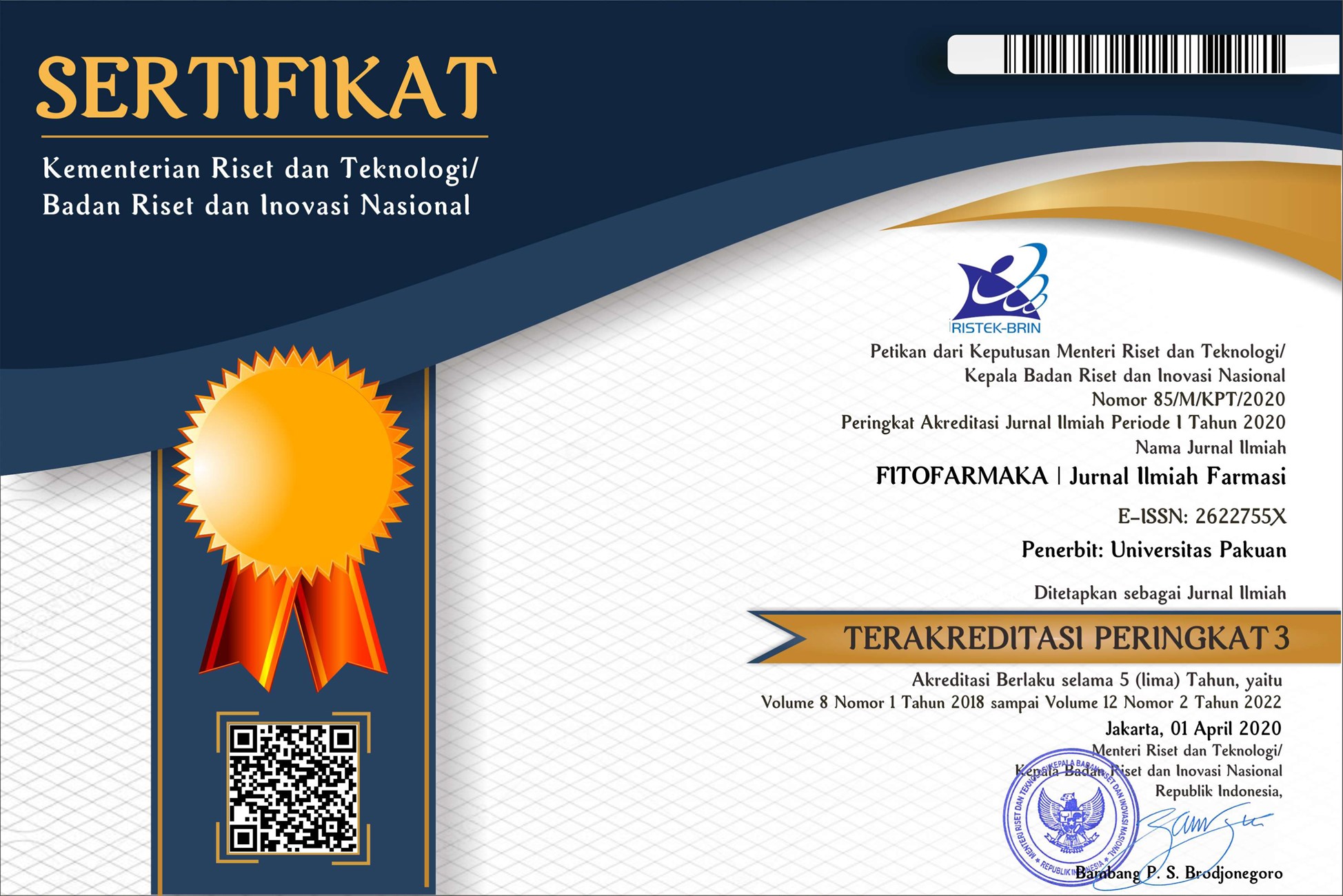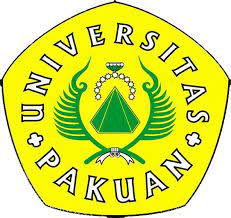Antibacterial Activity of Ocimum citriodorum Leave Extracts Against Shigella dysenteriae
Abstract
Dysentry is a disease caused by infection of Shigella dysenteriae (S. dysenteriae). This type of acute diarrhea characterized by the liquid stool mixed with blood and mucus caused by these bacteria. Ocimum citriodorum (O. citriodorum) leaves contain various chemical compounds that can inhibit the growth of diarrhea-causing bacteria. This study aims to determine the antibacterial activity of O. citriodorum leaves extracts obtained from graded extraction method against S. dysenteriae. The O. citriodorum leaves were extracted using ethanol, ethyl acetate, and n-hexane solvents sequentially. The Minimum Inhibitory Concentration (MIC) test was carried out using dilution method. The positive control used was 10 ppm ciprofloxacin (0.002%). The results showed that the extract of n-hexane, ethyl acetate, and ethanol of O. citriodorum leaves all three have antibacterial activity against S. dysenteriae with the same MIC value of 15%. The most effective MIC of n-hexane, ethyl acetate, and ethanol extract of O. citriodorum leaves was found at a concentration of 15% zone inhinbition with ethanol extract of O. citriodorum leaves
Keywords
References
Baker, S. & The, H.C. (2018). Recent insights into Shigella. Current opinion in infectious diseases, 31(5): 449-454. doi.org/10.1097/QCO.0000000000000475
Balouiri, M., Sadiki, M., & Ibnsouda, S,K. (2016). Methods in vitro evaluating antimicrobial activity: A review. Journal of pharmaceutical analysis, 6(2), 71-79. doi.org/10.1016/j.jpha.2015.11.005.
Bhargav, H. S., Shastri, S.D., Poornav, S.P., Darshan, K.M., & Nayak, M.M. (2016). Measurement of the Zone of Inhibition of an Antibiotic. IEEE, 1(16): 401-406. doi.org/10.1109/iacc.2016.82
Farha, M.A, El-Halfawy, O.M., Gale, R.T., MacNair, C.R., Carfrae, L.A., Zhang, X., Jentsch, N.G., Magolan, J., Eric, D., & Brown, E.D. (2019). Uncovering the hidden antibiotic potential of Cannabis.bioRxivorg. doi.org/10.1101/833392.
Flanagan, J.N., & Steck, T.R. (2017). The Relationship Between Agar Thickness and Antimicrobial Susceptibility Testing. Indian journal of microbiology, 57(4): 503–506. doi.org/10.1007/s12088-017-0683-z
Hidayat, R. & Wulandari, P. (2021). Methods of Extraction: Maceration, Percolation and Decoction. Eureka Herba Indonesia, 2(1): 73-79. doi.org/10.37275/ehi. v2i1.15
Khalil, A. (2013). Antimicrobial activity of ethanolic extracts of Ocimum basilicum leaf from Saudi Arabia. Biotechnology, 12(1), 61-64. doi.org/10.3923/biotech.2013.61.64.
Khalaf, H.A.A. (2021, May 2021). Extraction methods. Conference: pharmacognosy. doi.org/10.13140/RG.2.2.20271.66723.
Madduluri, S., Rao, K.B., & Sitaram, B. (2013). In vitro evaluation of antibacterial activity of five indigenous plants extract against five bacterial pathogen of human. International Journal of Pharmacy and Pharmaceutical Science, (5), 679-684.
Majdi, C., Pereira, C., Dias, M.I., Calhelha, R.C., Alves, M.J., Rhourri-Frih, B.Charrouf, Z., Barros, L., Amaral, J.S & Ferreira, I.C.F.R. (2020). Phytochemical Characterization and Bioactive Properties of Cinnamon Basil (Ocimum basilicum cv.‘Cinnamon’) and Lemon Basil (Ocimum citriodorum). PubMed. 9(5):369. doi.org/10.3390/antiox9050369.
Othman, L., Sleiman, A., & Abdel-Massih, R.M. (2019). Antimicrobial Activity of Polyphenols and Alkaloids in Middle Eastern Plants. Front Microbiol, 10: 911. doi.org/10.3389/fmicb.2019.00911.
Pertiwi, Y.U.P., Prajitno, A. & Fadjar, M. (2019). Analysis of Metabolic And Antibacterial Control of Mengkudu Leaf Extract (Morinda citrifolia) on the Bacteria of Aeromonas hydrophila. Research Journal of Life Science, 6(3): 172-183. doi.org/10.21776/ub.rjls.2019.006.03.3.
Radha, S. (2021). A review on phytochemical and pharmacological activities of selected Ocimum species. Journal of Pharmacognosy and Phytochemistry; 10(3): 100-108.
Shaikh, J.R. & Patil, M.K. (2020). Qualitative tests for preliminary phytochemical screening: An overview. International Journal of Chemical Studies, 8(2): 603-608. . doi.org/10.22271/chemi.2020.v8.i2i.8834
Tan, Z., Deng, J., Ye, Q., & Zhang, Z. (2022). The Antibacterial Activity of Natural-derived Flavonoids. Current Topics in Medicinal Chemistry, 22(12):1009-1019. doi.org/10.2174/1568026622666220221110506.
Tortora, G.J., Funke, & C.L. Case. (2010). Microbiology an introduction San Fransissco. USA: Addison Wesley Longman Inc.
Ullah, S., Rahman, K.U., Rauf, A., Hussain, A., Ullah, A., & Ramadan, M.F. (2020). Phenolic acids, flavonoids and antiradical activity of Ocimum sanctum and Ocimum basilicium leaves extracts. Journal of Medicinal and Spice Plants 2, 24(2):60-62.
Vu, T.T., Kim, H., Tran, V.K., Vu, H.D., Hoang, T.X., Han, J.W., Choi, Y.H., Jang, K.S., Choi, G.J., & Kim, J.C. (2017). Antibacterial activity of tannins isolated from Sapium baccatum extract and use for control of tomato bacterial wilt. Plos One, 12(7), 1-12. doi.org/10.1371/journal.pone.0181499.
World Health Organization. (2016). World health statistics 2016: monitoring health for the SDGs, sustainable development goals. World Health Organization.
Yahiaoui, R.Y., den Heijer, C.D., van Bijnen, E.M., Paget, W.J., Pringle, M., Goossens, H., Bruggeman, C.A., Schellevis, F.G., Stobberingh, E.E., & APRES Study Team. (2016). Prevalence and antibiotic resistance of commensal Streptococcus pneumoniae in nine European countries. Future Microbiology, 11(6): 737-744. doi.org/10.2217/fmb-2015-0011.
DOI: 10.33751/jf.v13i1.5643
 Abstract views : 332
Abstract views : 332
Refbacks
- There are currently no refbacks.















